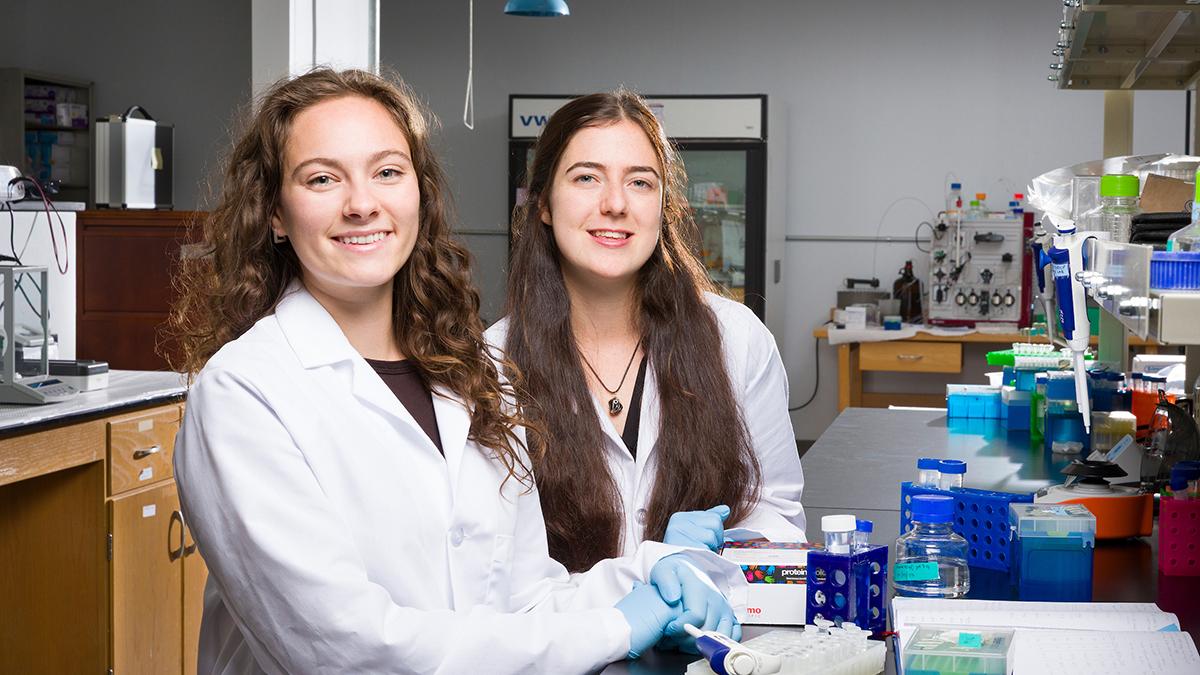
Brianna McVay (left) and Dana Wolfe pose in a laboratory at the joint FAMU-FSU College of Engineering in Tallahassee, Florida. The undergrad pair recently had a peer-reviewed article published in Langmuir (ACS). (Scott Holstein/FAMU-FSU College of Engineering)
Functional Amyloids Research: Transforming Drug Delivery and Healthcare Innovation
Brianna McVay and Dana Wolfe, undergraduate biomedical engineering student researchers at FAMU-FSU College of Engineering, have achieved a major milestone: their collaborative project on functional amyloids has been published in Langmuir, a top-tier scientific journal for chemistry and materials science.
Their article, “Functional Amyloids as Multifunctional Platforms for Targeted Drug Delivery and Immunotherapy,” explores how special protein-based nanostructures—known as functional amyloids—can revolutionize therapeutic applications.
Cutting-Edge Results and Implications for Biomedical Engineering

Amyloids are tiny structures formed from proteins and peptides. While harmful amyloids are associated with conditions such as Alzheimer’s, functional amyloids play positive roles in biology, providing innovative solutions for medical technology. Recent studies, including those from the Ramamoorthy lab at the National High Magnetic Field Laboratory, demonstrate their power to improve drug targeting, release mechanisms, and stability, advancing both patient outcomes and pharmaceutical research.
According to Professor Ayyalusamy (Rams) Ramamoorthy, one of the most exciting uses is amyloids’ potential as drug delivery platforms. Their ability to form stable, nanostructured fibrils makes them great for encapsulating and releasing drugs in a controlled way. This could improve drug stability, targeting and release, making functional amyloids a key focus for developing new drug technologies.
Student Impact and Scientific Recognition
McVay and Wolfe’s research, supported by the National Institute of Diabetes and Digestive and Kidney Diseases and the National Institutes of Health, demonstrates how undergraduate-led innovation in the FAMU-FSU College of Engineering contributes to real-world advancements in biomedical engineering.
As they prepare for doctoral studies, both seniors are dedicated to pushing the boundaries of biomaterials science.
Wolfe shares, “I am eager to investigate how biomaterials can stabilize therapeutic proteins and prevent misfolding in diseases. I want to create accessible treatments and mentor future engineers to view research as a way to serve people.”
McVay emphasizes, “I plan to focus on regenerative medicine and tissue engineering. I aim to bridge innovation and clinical applications to create solutions for real-world problems and mentor future engineers to foster curiosity and passion.”
Mentorship and Academic Journey
McVay and Wolfe’s research journey began under Professor Ramamoorthy, whose expertise spans protein aggregation, nanomaterials, and biomedical applications. Since spring 2024, the students have refined their scientific skills in his laboratory, where he challenged them to elevate their term project into publishable research.
Ramamoorthy explains, “I motivated them to submit a quality write-up as part of their term project, with the hope that their efforts could culminate in a valuable publication.” Supported by his mentorship, the students gradually transformed their classroom idea into a manuscript worthy of peer review.
“When Professor Ramamoorthy urged us to push our work further, Brianna and I embraced the challenge,” Wolfe says. “We worked with experts and studied the literature, transforming a classroom idea into a published study.”
For McVay, the experience was both formative and validating: “He encouraged us to treat our project as a real manuscript and seeing it in print felt surreal. It shows that even as undergraduates, our hard work can make a real impact in the scientific community.”
The undergrads showed a strong interest in publishing and worked closely with Ramamoorthy to refine their manuscript.
“They are outstanding students, and their hard work and enthusiasm made this project possible,” he said. “I am extremely proud of the research these two outstanding undergraduates accomplished.”
Their achievements signal a bright future for student-led innovation at the joint college, reminding us that pioneering discoveries often start in the classroom.
Editor’s Note: This article was edited with a custom prompt for Perplexity AI, an intelligent research assistant developed to optimize articles for SEO, readability and factual clarity while preserving the original reporting and content. All information and viewpoints remain those of the author and publication. This article was edited and fact-checked by college staff before being published. This disclosure is part of our commitment to transparency in our editorial process. Last edited: November 10, 2025.
RELATED ARTICLES
Unleashing the Potential of Undergraduate Researchers with Mentorship and Support
International Amyloid Disease Symposium Drew Global Experts to Campus
Research Shows How Insulin, Zinc and Ph Can Block Harmful Protein Clumps Linked to Type 2 Diabetes
